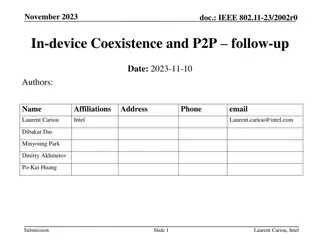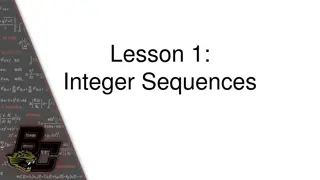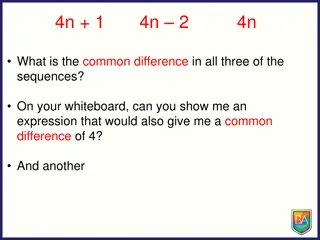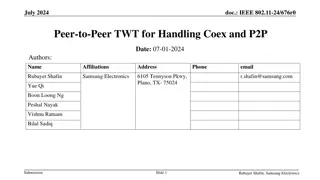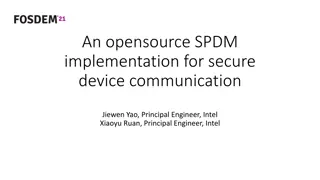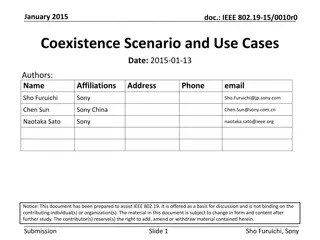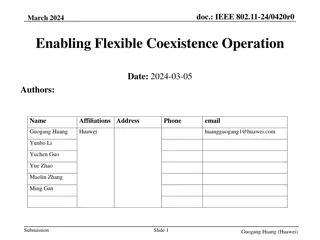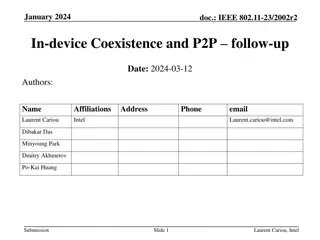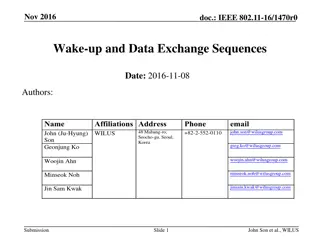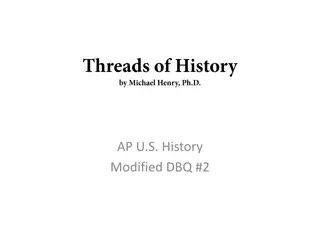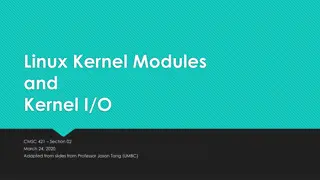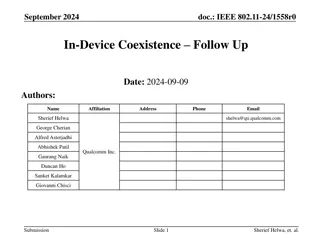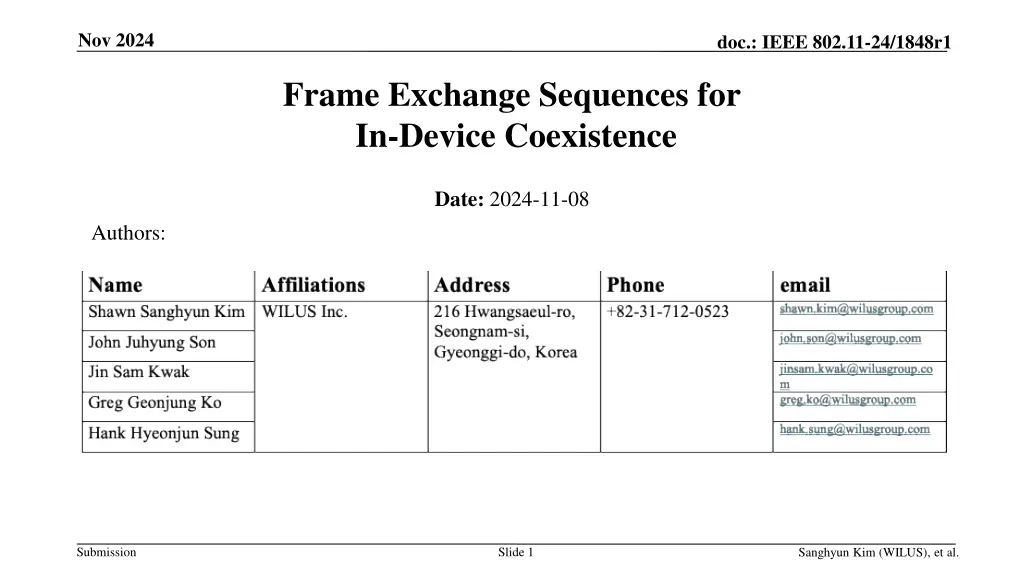
IEEE 802.11-24 In-Device Coexistence Frame Exchange Sequences
Explore the protocol IEEE 802.11-24/1848r1 focusing on frame exchange sequences for in-device coexistence. Learn about medium access recovery, synchronization procedures, and AP-assisted recovery. Discover mechanisms for reporting unavailability and enhancements to synchronization recovery for non-AP STAs.
Download Presentation

Please find below an Image/Link to download the presentation.
The content on the website is provided AS IS for your information and personal use only. It may not be sold, licensed, or shared on other websites without obtaining consent from the author. If you encounter any issues during the download, it is possible that the publisher has removed the file from their server.
You are allowed to download the files provided on this website for personal or commercial use, subject to the condition that they are used lawfully. All files are the property of their respective owners.
The content on the website is provided AS IS for your information and personal use only. It may not be sold, licensed, or shared on other websites without obtaining consent from the author.
E N D
Presentation Transcript
Nov 2024 doc.: IEEE 802.11-24/1848r1 Frame Exchange Sequences for In-Device Coexistence Date: 2024-11-08 Authors: Submission Slide 1 Sanghyun Kim (WILUS), et al.
Nov 2024 doc.: IEEE 802.11-24/1848r1 Introduction TGbn has agreed to define a mechanism for reporting unavailability as follows: [1] 11bn defines a mechanism for a non-AP STA to report unavailability at TXOP level and define or reuse/update existing mechanism for a non-AP STA to report long term (periodic) unavailability Signaling details have been defined in TGbn D0.1 (37.11): For periodic unavailability operation (PUO) mode Reusing P2P TWT signaling For dynamic unavailability operation (DUO) mode Unavailability start time/duration are reported via ICF, ICR and CRF i.e., via BSRP TF and Multi-STA BlockAck In this contribution, we discuss: Medium synchronization recovery procedure after the end of the unavailable period Management of the frame exchange sequences to provide opportunities for unavailability reporting Submission Slide 2 Sanghyun Kim (WILUS), et al.
Nov 2024 doc.: IEEE 802.11-24/1848r1 Problem 1: Medium access recovery after unavailable period If a DUO/PUO non-AP STA is unable to perform CCA on the primary 20 MHz subchannel during its unavailable period, the non-AP STA loses medium synchronization Similar to a STA operating on an NSTR/EMLSR link pair A DUO/PUO non-AP STA that has lost medium synchronization needs to recover its medium synchronization before accessing the medium The medium access recovery procedures in 11be (35.3.16.8) could be applied to the DUO/PUO non- AP STAs There are two type of medium sync recovery procedures: ED-based recovery & AP assisted recovery IDC service period (unavailable) (Periodic or Aperiodic) Non-AP STA MediumSyncDelay timer > 0 Initiates MediumSyncDelay timer Submission Slide 3 Sanghyun Kim (WILUS), et al.
Nov 2024 doc.: IEEE 802.11-24/1848r1 AP assisted medium synchronization recovery Recap: (35.3.16.8.3) AP assisted medium synchronization recovery procedure A non-AP MLD can transmit AAR Control subfield through one link to request trigger frame on the other link The AP MLD should schedule a trigger frame to the requested link by the AAR Control subfield Submission Slide 4 Sanghyun Kim (WILUS), et al.
Nov 2024 doc.: IEEE 802.11-24/1848r1 Enhancements to the AP assisted medium synchronization recovery for the DUO non-AP STA To enable AP assisted medium sync recovery procedure for DUO non-AP STAs, the request for a trigger frame should be made on the link where the DUO non-AP STA is operating Since the defined AP assisted medium sync recovery procedure is MLD(cross-link) operation, a DUO non-AP STA that lacks any other non-AP STA affiliated with the same MLD is unable to utilize the AP assisted recovery procedure Therefore, ICR/CRF transmitted by a DUO non-AP STA needs to include indication for requesting a trigger frame for that DUO non-AP STA A DUO non-AP STA requests a trigger frame using ICR/CRF carrying unavailability info (e.g., start time & duration) The AP may then schedule a trigger frame for the DUO non-AP STA after the reported unavailable period ends Report IDC-related info. + TF request Scheduled TF by the received request PPDU TF ICF AP ICR CRF Data Unavailable Non-AP STA MediumSyncDelay timer > 0 Submission Slide 5 Sanghyun Kim (WILUS), et al.
Nov 2024 doc.: IEEE 802.11-24/1848r1 Problem 2: Unreportable unavailability information There might be a case where a DUO non-AP STA has prior knowledge of an upcoming aperiodic unavailable period but does not have opportunities to report it until it begins Long PPDU (re-Tx) Long PPDU ICF AP ICR Unavailable Non-AP STA No IDC-related info. t IDC info is obtained internally (will be unavailable from t) To prevent the issue described above, the AP should properly manage its frame exchange sequences i.e., the AP should manage length of the DL PPDUs to ensure that the DUO non-AP STA can respond at least one ICR/CRF before the unavailable period begins If the AP simply shortening length of its PPDU for this purpose, network efficiency would degrade Therefore, the AP should manage length of its PPDU based on the capabilities of the recipient non-AP STA(s) Submission Slide 6 Sanghyun Kim (WILUS), et al.
Nov 2024 doc.: IEEE 802.11-24/1848r1 Providing opportunities for unavailability reporting Each STA may have different capabilities in acquiring its unavailability information in advance The timing of acquiring unavailability information may vary depending on the implementation and the source of IDC interference Therefore, a DUO non-AP STA should indicate its capability to acquire unavailability information in advance An AP adjust the length of DL PPDUs based on the indicated capability as follows: If a recipient STA has indicated that it can acquire unavailability information at least x ms before the unavailable period begins, the AP should manage its DL PPDU length to ensure that at least one CRF (M-BA) is solicited within x ms (Managed length) DL PPDU ICF CF-End AP Report IDC-related info. No IDC-related info. Capa. Info. (x ms) CRF ICR Unavailable Non-AP STA < x ms t x ms IDC info is obtained internally (will be unavailable from t) Submission Slide 7 Sanghyun Kim (WILUS), et al.
Nov 2024 doc.: IEEE 802.11-24/1848r1 Providing opportunities for unavailability reporting (cont d) If a DUO non-AP STA with a pre-acquisition capability of x ms responds with "No-IDC", its AP can confirm that the DUO non-AP STA will be available for the next x ms In other words, when the DUO non-AP STA indicates "No-IDC", the AP obtains information about that DUO non-AP STA's available duration, which is useful for managing the frame exchange sequence e.g., an AP may skip the ICF/ICR exchange sequence (for acquiring unavailability info.) if the TXOP responder of the new TXOP is expected to be available until the end of the TXOP New TXOP Frame exchanges (w/o ICF/ICR for IDC) Last PPDU of the previous TXOP AP Report IDC-related info. No IDC report is valid No IDC CRF Unavailable CRF Non-AP STA x ms Submission Slide 8 Sanghyun Kim (WILUS), et al.
Nov 2024 doc.: IEEE 802.11-24/1848r1 Summary Medium synchronization recovery A non-AP STA that has lost medium synchronization during its unavailable period needs to recover medium synchronization Reusing the AP assisted medium sync recovery procedure defined in 11be for the DUO non-AP STAs could be considered Unreportable unavailability information The AP should ensure that the DUO non-AP STA can respond at least one ICF/CRF before the unavailable period begins To achieve this, a DUO non-AP STA should inform the AP of how early it can acquire unavailability information Submission Slide 9 Sanghyun Kim (WILUS), et al.
Nov 2024 doc.: IEEE 802.11-24/1848r1 Straw Poll 1 Do you agree to add the following to the TGbn SFD? A STA that has lost medium synchronization during its unavailable period shall recover medium synchronization before accessing the medium. Reuse/update existing mechanisms in 35.3.16.8 for the STAs operating in the DUO/PUO mode. Submission Slide 10 Sanghyun Kim (WILUS), et al.
Nov 2024 doc.: IEEE 802.11-24/1848r1 Straw Poll 2 Do you agree to add the following to the TGbn SFD? A non-AP STA supporting DUO mode indicates to the DUO supporting AP its capability to acquire unavailability information in advance. The DUO supporting AP should manage frame exchange sequences within its TXOP to ensure that a non-AP STA operating in DUO mode can report its acquired unavailability information before becoming unavailable. Submission Slide 11 Sanghyun Kim (WILUS), et al.
Nov 2024 doc.: IEEE 802.11-24/1848r1 References [1] 11-24/0209 Specification Framework for TGbn [2] 11-23/1964 Coexistence Protocols for UHR [3] 11-23/2002 In-device coexistence and interference follow-up [4] 11-24/0420 Enabling Flexible Coexistence Operation [5] 11-24/0494 in-device coexistence follow up [6] 11-24/0543 Coexistence Protocols for UHR follow up [7] 11-24/0834 Some Details on In-Device Coexistence [8] 11-24/0856 Further Discussions on In-Device Coexistence [9] 11-24/1109 More consideration for in-device-coexistence [10] 11-24/1170 Further Considerations on In-Device Coexistence [11] 11-24/1247 ICF ICR Design For Coex [12] 11-24/1504 Considerations on Aperiodic In-device Coexistence [13] 11-24/1558 In Device Coexistence-Follow Up [14] 11-24/1559 In-device-coexistence next steps [15] 11-24/1562 in-device coexistence follow up Submission Slide 12 Sanghyun Kim (WILUS), et al.

